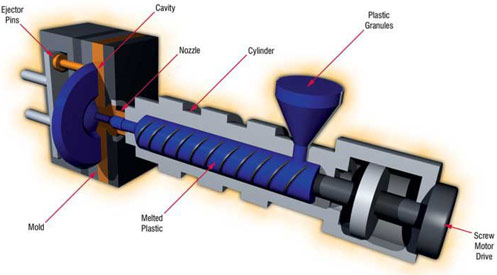
Injection Molding is accomplished by injection molding machines (IMM) of various sizes.
Injection molding resin is fed to the machine through the injection molding hopper. Colorants are usually fed to the machine directly after the hopper. The molding resins enter the injection barrel by gravity though the feed throat. Upon entrance into the barrel, the resin is heated to the appropriate melting temperature. The resin is injected into the mold by a reciprocating screw or a ram injector.The reciprocating screw apparatus is attached to the screw motor drive in the above illustration. The reciprocating screw offers the advantage of being able to inject a smaller percentage of the total shot (amount of melted resin in the barrel). The ram injector must typically inject at least 20% of the total shot while a screw injector can inject as little as 5% of the total shot. Essentially, the screw injector is better suited for producing smaller parts.
The mold is the part of the machine that receives the plastic and shapes it appropriately. (see image, The left end)The mold is cooled constantly to a temperature that allows the resin to solidify and be cool to the touch. The mold plates are held together by hydraulic or mechanical force. The clamping force is defined as the injection pressure multiplied by the total cavity projected area. Each resin compound has a calculated shrinkage value associated with it.
